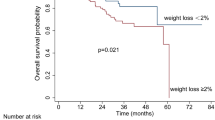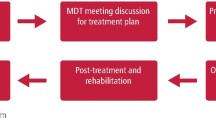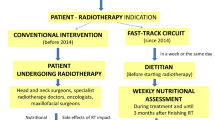Abstract
Background/objectives:
Malnutrition decreases the cancer patient’s ability to manage treatment, affects quality of life and survival, and is common among head and neck (HN) cancer patients due to the tumour location and the treatment received. In this study, advanced HN cancer patients were included and followed during 2 years in order to measure their energy intake, choice of energy sources and to assess problems with dysphagia. The main purpose was to explore when and for how long the patients had dysphagia and lost weight due to insufficient intake and if having a PEG (percutaneous endoscopic gastrostomy) in place for enteral nutrition made a difference.
Subjects/methods:
One hundred thirty-four patients were included and randomised to either a prophylactic PEG for early enteral feeding or nutritional care according to clinical praxis. At seven time points weight, dysphagia and energy intake (assessed as oral, nutritional supplements, enteral and parenteral) were measured.
Results:
Both groups lost weight the first six months due to insufficient energy intake and used enteral nutrition as their main intake source; no significant differences between groups were found. Problems with dysphagia were vast during the 6 months. At the 6-, 12- and 24-month follow-ups both groups reached estimated energy requirements and weight loss ceased. Oral intake was the major energy source after 1 year.
Conclusions:
HN cancer patients need nutritional support and enteral feeding for a long time period during and after treatment due to insufficient energy intake. A prophylactic PEG did not significantly improve the enteral intake probably due to treatment side effects.
This is a preview of subscription content, access via your institution
Access options
Subscribe to this journal
Receive 12 print issues and online access
$259.00 per year
only $21.58 per issue
Buy this article
- Purchase on Springer Link
- Instant access to full article PDF
Prices may be subject to local taxes which are calculated during checkout



Similar content being viewed by others
References
Paccagnella A, Morello M, Da Mosto MC, Baruffi C, Marcon ML, Gava A et al. Early nutritional intervention improves treatment tolerance and outcomes in head and neck cancer patients undergoing concurrent chemoradiotherapy. Support Care Cancer 2010; 31: 867–876.
Larsson M, Hedelin B, Johansson I, Athlin E . Eating problems and weight loss for patients with head and neck cancer: a chart review from diagnosis until one year after treatment. Cancer Nurs 2005; 28: 425–435.
Ravasco P, Monteiro-Grillo I, Vidal PM, Camilo ME . Nutritional deterioration in cancer: the role of disease and diet. Clin Oncol 2003; 15: 443–450.
Kubrak C, Olson K, Jha N, Jensen L, McCargar L, Seikaly H et al. Nutrition impact symptoms: key determinants of reduced dietary intake, weight loss, and reduced functional capacity of patients with head and neck cancer before treatment. Head Neck 2009; 32: 290–300.
Petruson KM, Silander EM, Hammerlid EB . Quality of life as predictor of weight loss in patients with head and neck cancer. Head Neck 2005; 27: 302–310.
Capuano G, Grosso A, Gentile PC, Battista M, Bianciardi F, Di Palma A et al. Influence of weight loss on outcomes in patients with head and neck cancer undergoing concomitant chemoradiotherapy. Head Neck 2008; 30: 503–508.
van Bokhorst-de van der S, van Leeuwen PA, Kuik DJ, Klop WM, Sauerwein HP, Snow GB et al. The impact of nutritional status on the prognoses of patients with advanced head and neck cancer. Cancer 1999; 86: 519–527.
van den Berg MG, Rasmussen-Conrad EL, van Nispen L, van Binsbergen JJ, Merkx MA . A prospective study on malnutrition and quality of life in patients with head and neck cancer. Oral Oncol 2008; 44: 830–837.
Garg S, Yoo J, Winquist E . Nutritional support for head and neck cancer patients receiving radiotherapy: a systematic review. Support Care Cancer 2010; 7: 223–225.
Nugent B, Lewis S, O’Sullivan JM . Enteral feeding methods for nutritional management in patients with head and neck cancers being treated with radiotherapy and/or chemotherapy. Cochrane Database Syst Rev 2010 CD007904.
Corry J, Poon W, McPhee N, Milner AD, Cruickshank D, Porceddu SV et al. Prospective study of percutaneous endoscopic gastrostomy tubes versus nasogastric tubes for enteral feeding in patients with head and neck cancer undergoing (chemo)radiation. Head Neck 2009; 31: 867–876.
Silander E, Nyman J, Bove M, Johansson L, Larsson S, Hammerlid E . Impact of prophylactic percutaneous endoscopic gastrostomy on malnutrition and quality of life in patients with head and neck cancer—a randomized study. Head Neck 2010; 3.
Silander E, Nyman J, Bove M, Johansson L, Larsson S, Hammerlid E . The use of prophylactic percutaneous endoscopic gastrostomy and early enteral feeding in patients with advanced head and neck cancer-A prospective longitudinal study e-SPEN, the European e-Journal of Clinical Nutrition and Metabolism 2010 e166–e172.
Bingham SA, Cassidy A, Cole TJ, Welch A, Runswick SA, Black AE et al. Validation of weighed records and other methods of dietary assessment using the 24 h urine nitrogen technique and other biological markers. Br J Nutr 1995; 73: 531–550.
The National Board of Health and Welfare (Socialstyrelsen) is a government agency in Sweden under the Ministry of Health and Social Affairs, 2011.
Elia M, Stratton R . On the ESPEN guidelines for nutritional screening 2002. Clin Nutr 2004; 23: 131–132.
Bjordal K, Hammerlid E, Ahlner-Elmqvist M, de Graeff A, Boysen M, Evensen JF et al. Quality of life in head and neck cancer patients: validation of the European Organization for Research and Treatment of Cancer Quality of Life Questionnaire-H&N35. J Clin Oncol 1999; 17: 1008–1019.
Fayers P, Bjordal K, Groenvold M, Curran D, Bottomoley A Eortc QLQ—C30 scoring manual. EORTC: Belgium, 2001.
Osoba D, Rodrigues G, Myles J, Zee B, Pater J . Interpreting the significance of changes in health-related quality-of-life scores. J Clin Oncol 1998; 16: 139–144.
Nguyen NP, North D, Smith HJ, Dutta S, Alfieri A, Karlsson U et al. Safety and effectiveness of prophylactic gastrostomy tubes for head and neck cancer patients undergoing chemoradiation. Surg Oncol 2006; 15: 199–203.
van den Berg MG, Rasmussen-Conrad EL, Gwasara GM, Krabbe PF, Naber AH, Merkx MA . A prospective study on weight loss and energy intake in patients with head and neck cancer, during diagnosis, treatment and revalidation. Clin Nutr [malnutrition] 2006; 25: 765–772.
Jager-Wittenaar H, Dijkstra PU, Vissink A, Langendijk JA, van der Laan BF, Pruim J et al. Changes in nutritional status and dietary intake during and after head and neck cancer treatment. Head Neck 2010; 33: 863–870.
Decarli A, Franceschi S, Ferraroni M, Gnagnarella P, Parpinel MT, La Vecchia C et al. Validation of a food-frequency questionnaire to assess dietary intakes in cancer studies in Italy. Results for specific nutrients. Ann Epidemiol 1996; 6: 110–118.
Luhrmann PM, Herbert BM, Gaster C, Neuhåuser-Berthold M . Validation of a self-administered 3-day estimated dietary record for use in the elderly. Eur J Nutr 1999; 38: 235–240.
Nugent B, Lewis S, O’Sullivan JM . Enteral feeding methods for nutritional management in patients with head and neck cancers being treated with radiotherapy and/or chemotherapy. Cochrane Database Syst Rev 2010; 3: CD007904.
Wiggenraad RG, Flierman L, Goossens A, Brand R, Verschuur HP, Croll GA et al. Prophylactic gastrostomy placement and early tube feeding may limit loss of weight during chemoradiotherapy for advanced head and neck cancer, a preliminary study. Clin Otolaryngol 2007; 32: 384–390.
Mekhail TM, Adelstein DJ, Rybicki LA, Larto MA, Saxton JP, Lavertu P . Enteral nutrition during the treatment of head and neck carcinoma: is a percutaneous endoscopic gastrostomy tube preferable to a nasogastric tube? Cancer 2001; 91: 1785–1790.
Ahlberg A, al-Abany M, Alevronta E, Friesland S, Hellborg H, Mavroidis P et al. Esophageal stricture after radiotherapy in patients with head and neck cancer: experience of a single institution over 2 treatment periods. Head Neck 2010; 32: 452–461.
Langmore S, Krisciunas GP, Miloro KV, Evans SR, Cheng DM, Does PEG . use cause dysphagia in head and neck cancer patients? Dysphagia 2012; 27: 251–259.
Garcia-Peris P, Paron L, Velasco C, de la Cuerda C, Camblor M, Breton I et al. Long-term prevalence of oropharyngeal dysphagia in head and neck cancer patients: Impact on quality of life. Clin Nutr 2007; 26: 710–717.
Acknowledgements
This study was funded by: Göteborg Medical Society; Assar Gabrielssons Foundaiton fund; Laryngfonden Foundation; The Research and Development Council Västra Götaland County (Sweden) and Adlerbertska Foundation.
Author information
Authors and Affiliations
Corresponding author
Ethics declarations
Competing interests
The authors declare no conflict of interest.
Rights and permissions
About this article
Cite this article
Silander, E., Jacobsson, I., Bertéus-Forslund, H. et al. Energy intake and sources of nutritional support in patients with head and neck cancer—a randomised longitudinal study. Eur J Clin Nutr 67, 47–52 (2013). https://doi.org/10.1038/ejcn.2012.172
Received:
Revised:
Accepted:
Published:
Issue Date:
DOI: https://doi.org/10.1038/ejcn.2012.172
Keywords
This article is cited by
-
Early versus conventional nutritional intervention in head and neck cancer patients before radiotherapy: benefits of a fast-track circuit
European Journal of Clinical Nutrition (2021)
-
Impact of early nutrition counseling in head and neck cancer patients with normal nutritional status
Supportive Care in Cancer (2021)
-
Nutritional status in patients with head and neck cancer undergoing radiotherapy: a longitudinal study
Supportive Care in Cancer (2019)
-
New radiotherapy techniques do not reduce the need for nutrition intervention in patients with head and neck cancer
European Journal of Clinical Nutrition (2015)
-
The Effect of Prophylactic Percutaneous Endoscopic Gastrostomy (PEG) Tube Placement on Swallowing and Swallow-Related Outcomes in Patients Undergoing Radiotherapy for Head and Neck Cancer: A Systematic Review
Dysphagia (2015)



